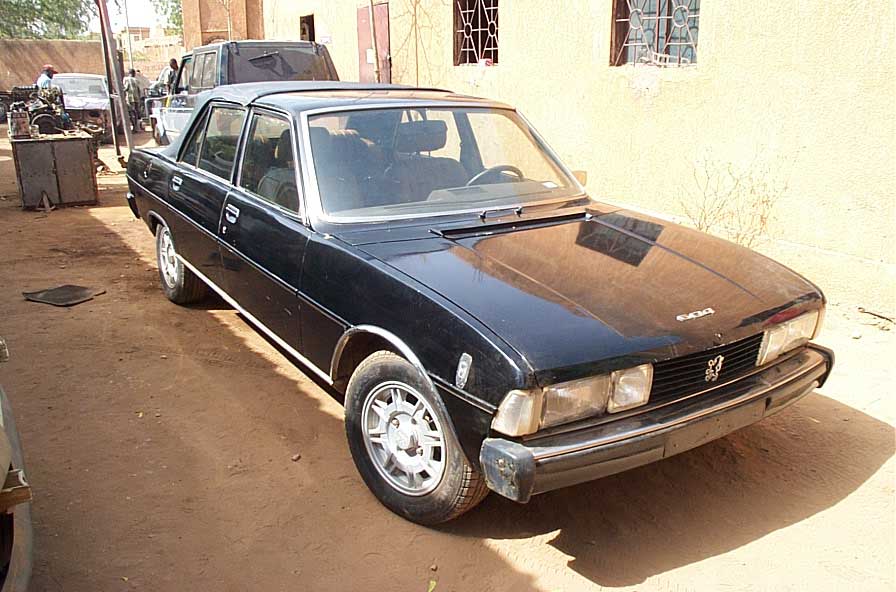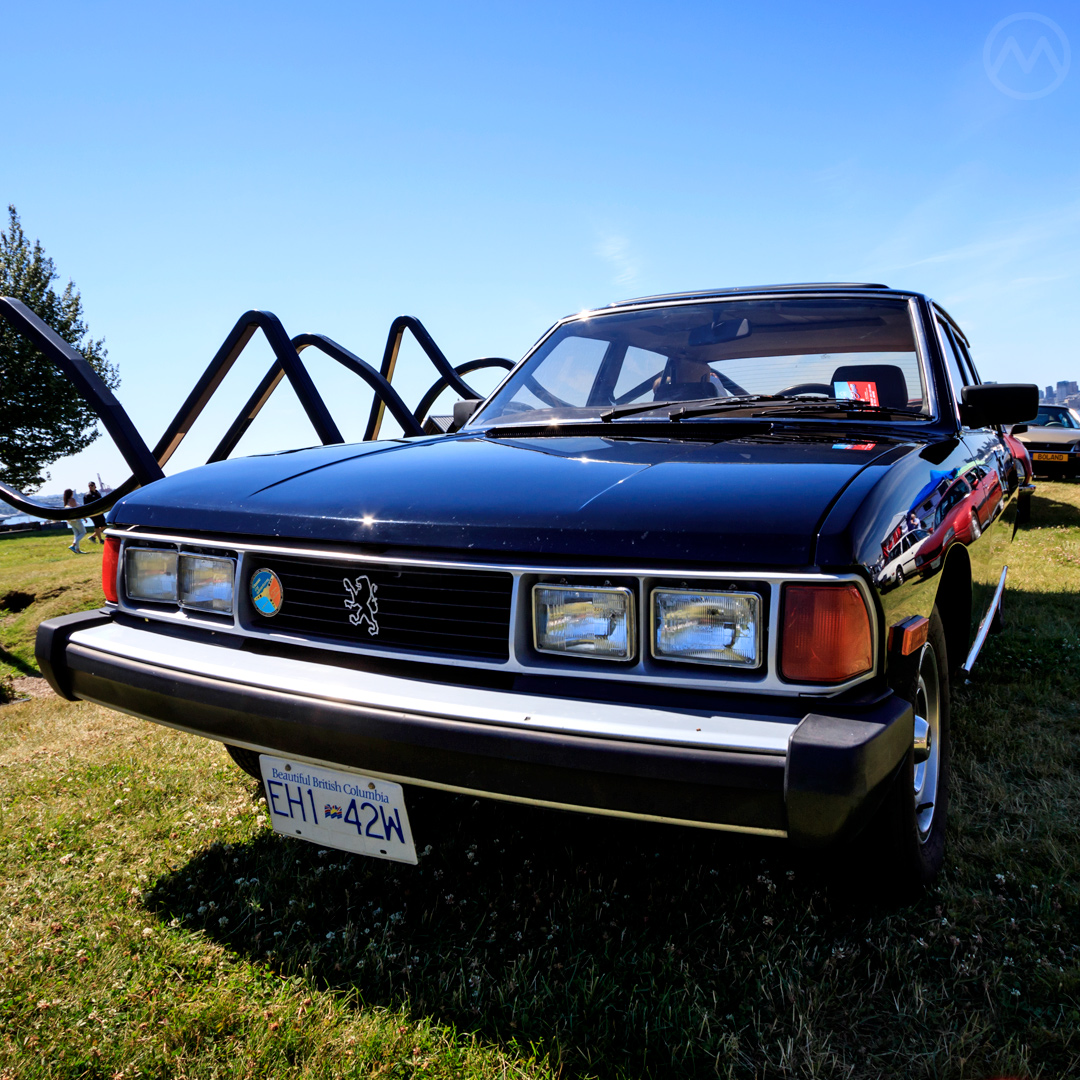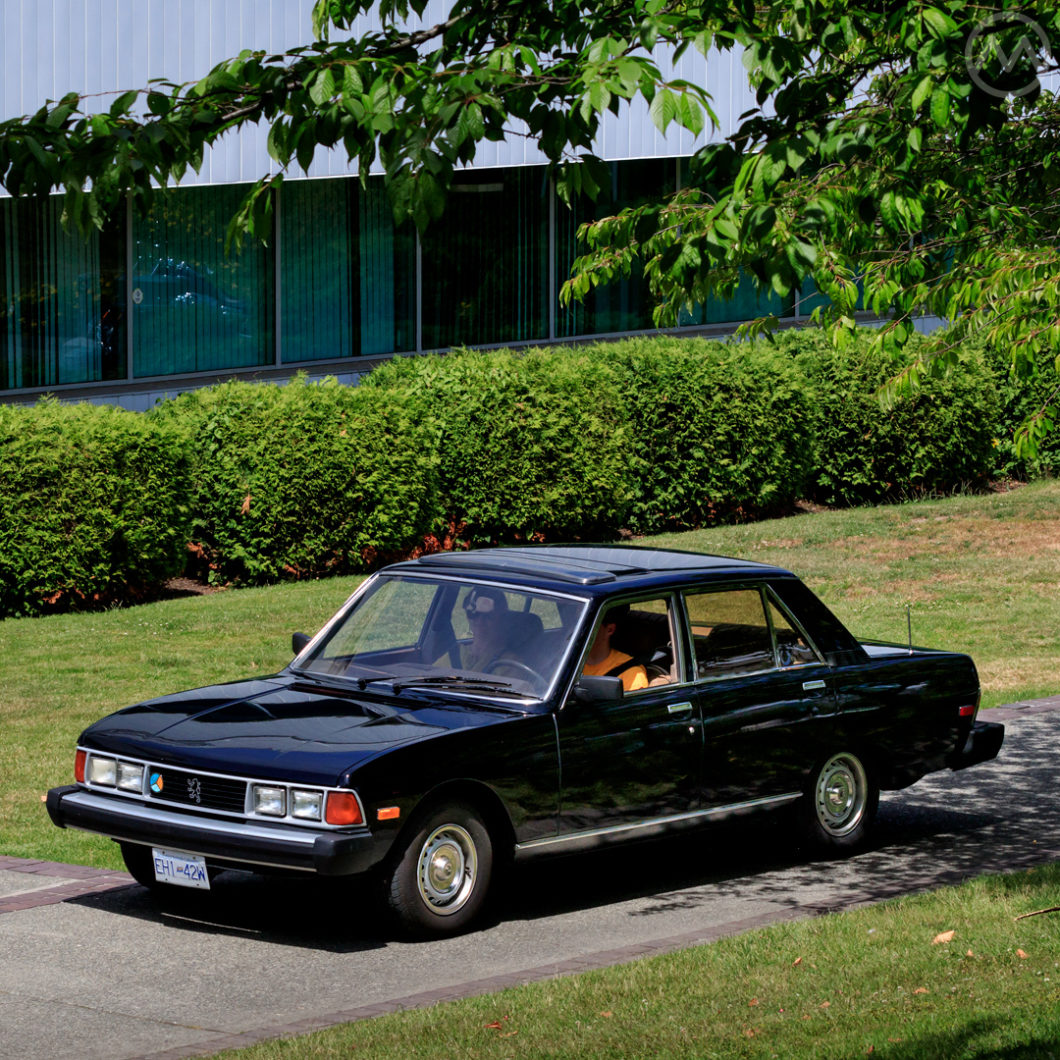The 604 was Peugeot’s first “executive car,” and the first time in 40 years that it had fielded a large car at all. Though the 402 was a fairly big car for a pre-war European, Peugeot had stuck to smaller cars and mid-size family fare ever since. But what do you do when a buyer wants to trade up from a family car to a luxury car?
The postwar years in France (1945-75), later defined as Les Trente Glorieuses (“the glorious thirty”), were ones of explosive economic growth and until the first OPEC crisis. Disturbances and strikes of 1968 aside, French standards of living and wages improved continuously in the period and that meant more people wanted fancier things.
France’s punitive displacement-based tax laws wiped out the great French Grand Routiers of old by the early 1960s, but French buyers still bought luxury cars – particularly from Mercedes but also the plusher versions of the Citroën DS.
Peugeot’s 504 was a dead-on match for the four-cylinder Mercedes W115. Both were launched in 1968 and both won plaudits for their durability and engineering. The 504’s European run would outsell the Merc by more than a million cars, and it was arguably the more comfortable and better handler of the pair. But Mercedes had higher-rung cars to trade up to – the six-cylinder W115 and the larger S-class W108/109. Peugeot did not.
With even mainstream manufacturers like Opel building premium cars in the 1960s and 1970s, Peugeot began, in 1970, to work on a large executive car of its own. The resulting 604 arrived just as Les Trente were coming to a close, and it never did capture the wider public’s interest. It consistently got good reviews over a nearly ten-year run, but ended up an also-ran and sometimes labeled a lemon. Its story is one of compromise.
Stretching Out
Sochaux’s goal for the 604 was to produce something that lay between the 504 and the W108 Mercedes. In the traditional mold, it would be stylish but conservative.
Peugeot was the most conservative of the French Big 4 in many ways. It did not shy away from innovation – it brought diesels to mainstream acceptance early on (though not as early as Mercedes) and built a light, small, transverse front-driver (the 204) from 1965. However, Peugeot did not embark on wild adventures like Citroën or have the resources of the state at hand like Renault.
It was a prudent company and its cars were conservative and conservatively styled. With no history of luxury cars and no way around the taxation problem, the new “executive” Peugeot would have to make money in a relatively narrow band of the market (luxurious but nothing over 2.8 liters) at home but also be globally competitive.
To save on development costs, the 604 would ride an evolved version of the existing 504 architecture. It was stretched two inches and retained the front doors, bulkhead, much of the floorpan, and the 504’s excellent suspension.
The 604’s wheelbase was 2.2” (5.6cm) longer than the 504, which doesn’t sound like much but somehow produced a cavernous, almost limousine-like rear seat. To match, the rear doors were different from the 504 – longer and with wider openings and straighter edges.
The car was styled by Pininfarina as many Peugeots had been. It’s not properly attributed in many places but was primarily the work of Pininfarina’s ace Aldo Brovarone. Brovarone styled many cars in this period and was closely associated with the 504 and its Coupe derivative. He also styled the Lancia Gamma Coupe, which bore some resemblance to the 604 in certain ways.
The 604’s styling was clean, conservative, and upright – unadorned and elegant in European spec, with flush “aero” headlights and slim bumpers. It was understated but good looking in its original form. Unfortunately when it came time to ship the car to North America, some, er, changes had to be made. More on that later.
The 604 was an extremely comfortable car to ride in – soft, capacious, but well-supported seats and the gentle but properly damped suspension of the 504 saw to that. Needing to compete with Citroën and knowing that a soft and comfy ride were paramount to French customers, Peugeot did very well on these virtues but the car wasn’t vague or floaty like a Cadillac – it could handle respectably.
The early 604s were powered by the Peugeot-Renault-Volvo (PRV) V6, developed jointly by all parties to hopefully save money on the huge expense of creating a new engine family. Originally, the PRV was meant to be a V8, which is in part why it is a 60-degree engine. But repeated delays and program problems eventually mutated it into a V6. Early ones were underpowered and not always reliable, though over time the PRV grew into a turbocharged powerhouse. Not in the 604, however.

The Volvo 264 was the first car to use this engine, and the 604 followed about a year later, by which time products from all three participants were on the market.
When the car was planned, the economy was strong and fuel prices moderate. But by the time it arrived, the first OPEC crisis had passed and Peugeot had to scramble to produce a car with a small-ish engine that still got decent fuel economy. In this respect, the 604 fared poorly – in the 3,200-lb. car, the PRV would only return 16 mpg, sometimes less. It was also never in much of a hurry.
The car premiered at the 1975 Geneva show and immediately got good marks from the press for its appearance, roomy interior, and driving dynamics if not its speed. Things should have gone well – the 604 repeatedly beat the BMW 528 in various tests, and compared well even in 1977-78 to the newer Mercedes W123.
Even as late as comparisons with the W126 Mercedes earned the 604 praise, but sales never really took off.
The 604 was much cheaper than a comparably equipped Mercedes in every market, but its badge worked against it. While Opel/Vauxhall and Ford had near-luxury cars, they were cheaper than the 604, as were bargain-spec Mercedes models. A Merc 230 might be basic by comparison, but it was a Mercedes. Meanwhile, Renault launched an executive car of its own – the front-drive R30 – powered by the same PRV.
In France, though, the 604 had at least one really big fan. French President Valery Giscard d’Estaing, who had helped broker Peugeot’s takeover of Citroën in 1974 hot on the heels of his election, used a 604 as his Presidential car. The reform-minded Giscard d’Estaing was a conservative but technocratic and socially liberal leader who rode the Paris Metro, wore regular business suits, and promoted the TGV and France’s Nuclear power network. The 604 fit him well.
Several less virtuous leaders liked the 604 too, including Niger’s Seyni Kountché, who had a Chapron-built 604 Landaulet. For the limo trade both Chapron and (primarily) Hueliez offered stretched 604s.
Coming to America
Peugeot’s North American operation was never very large, but it focused only on the top-spec models from France and was often referred to as “the French Mercedes.” In part, this might have been due to the physical and philosophical similarities between the Peugeot 403 and the lower-end Mercs of the late 1950s. At that time, Peugeot sold more cars in the USA than Mercedes, but fortunes changed in the 1960s – Mercedes-Benz USA grew quickly, Peugeot’s U.S. operation only modestly.
Peugeot was also similar in customers’ eyes to Mercedes in another way – the availability of diesel engines from 1974. Peugeot had already offered diesels since 1958, but they only came stateside around the time of OPEC 1. At that time only Peugeot and Mercedes offered Diesel power in the USA, and this would be a major factor for both companies U.S. operations over the next decade.

Building an actual direct Mercedes rival, Peugeot had planned from the start to market the car in the U.S. and Canada, and it arrived in the summer of 1977.
U.S. regulations meant a major rework of the front and rear of the car, and not necessarily for the better. Huge bumpers were added and the pretty flush lamps were binned for a pair of rectangular sealed-beams as seen on a 1975 Cadillac. The Euro lamps gave better light and looked better, but were banned.
These changes were not expensive, but they did look odd compared to the clean Euro versions. And in America, an “unadorned” luxury car was still a new idea, and the car looked plain compared to a Mercedes.
At first the U.S. version used a 133-hp 2.7L PRV, then later a 2.8 of similar power. Early ones had a four-speeder or a Borg-Warner 3-speed auto, later ones had a five-speeder or a GM Europe 3A and more torque to surf on – but none were in a hurry, just like the European models. U.S. cars were carbureted and never got the eventual fitment of Bosch Fuel Injection that other markets did.
A match for the W123 280E in size, it was not as fast – but it was nearly half the price. Very few buyers seemed interested and Peugeot’s small dealer network, confined mostly to the coasts and populous midwestern cities, didn’t help.
The Diesel 604
If the 604 is remembered for any firsts, it’s that it was the first (production) Turbodiesel car to be sold in Europe. A decade later Turbodiesels would be common, but the 604 Turbo D was a brand new idea for Europeans in 1979. In the USA, Mercedes had already launched the Turbodiesel W116 300SD, but that car was exclusive to North America despite being built in Germany.
To address the poor gas mileage of the gas 604s and broaden the range, Peugeot fitted a 2.3L Turbodiesel four from its subsidiary division Indénor.
The result was an even slower car but one with spectacular economy for a big car (as much 32mpg on the highway) and rock-tough reliability, though the early XD2S engine could be hard to start in very cold climates like many diesels at the time. The economy numbers reinvigorated the 604 to some degree in the wake of OPEC II but it was still a slow seller.
In the USA and Canada gas versions of the 604 were dropped entirely after 1981 and only the Turbodiesel remained. Diesels proved to be a bonanza for Peugeot Motors of America (which evolved from the earlier Peugeot Inc. distributor in 1977) and sales grew fairly rapidly in the early 1980s, reaching a peak of 20,000 U.S. sales in 1984.
That happened to be the final year of availability of the 604 in North America, but the big flagship was barely a blip on the radar by then, with just a few hundred units sold. Instead it was the 505 that was generating the lion’s share of sales.

Over its lifetime, the 604 sold just about 153,000 units – a disappointing number for Peugeot but not so bad in hindsight. It was still on sale in Europe into 1985, but there too it was a rare sight new. It did not stop winning comparison tests but it always seemed trapped between near-luxury mainstreamers and low-end Premium cars, and it didn’t really change with time. A 1984 car looked broadly similar inside to a 1976 car, and by the eighties interior plastics had moved on.
Peugeot tried again with big luxury executive cars in 1989 (605) and 1999 (607) but had even less success with those cars. The 605 was slated to come to North America, but Peugeot’s sagging stateside fortunes led it to withdraw from the U.S. and Canada in August, 1991, just before the eve of the 605’s introduction.
Without much support and with a relatively small number of 604s sold in North America, survivors are rare now, and this black Turbodiesel is one of the nicest. It was seen in 2018 at the Vancouver Father’s Day French & Italian event.


Amazing content you’ve gotten right here.
The Canadian market 604 SL V6 had the European headlamps. E-Code lights have been legal in Canada for 40+ years and the more “enlightened” importers took advantage of this, Peugeot and Renault chiefly among them. When the Turbo Diesel arrived the awful second version US headlights arrived. Ugh.
Oh yeah and Peugeot sold 225 of these in British Columbia alone. Ten Turbo Diesels and 215 V6 versions with the excellent headlights.